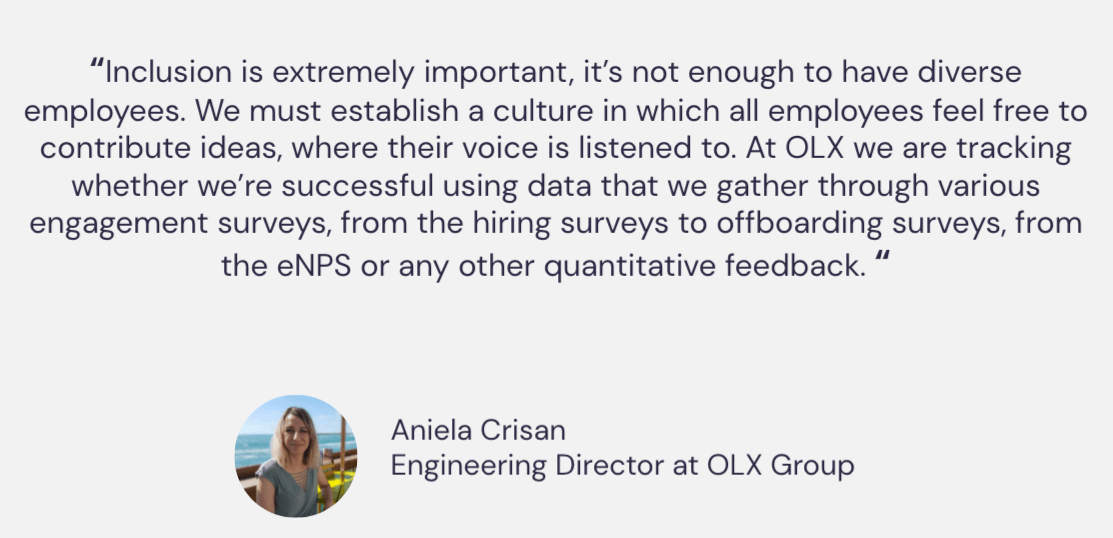The Rise of Femtech: At Home Fertility
Grip Co-Founder, Ling Lin on femtech’s evolution
We've detected you're from the Netherlands, if you'd like you can view this page in Dutch!
View Dutch Stay hereWe've detected you're from Germany, if you'd like you can view this page in German!
View German Stay hereAdvice from Aniela Crisan, Engineering Director at OLX Group Portugal

Can closing the gender gap in tech give companies different approaches to problem solving? Despite significant progress made, gender equality in tech remains to be a global challenge. By now, you probably know that equaling the number of men and women on your team can bring many benefits, but you’re having trouble diversifying your company? Every company has a responsibility to create a culture where everyone feels welcomed, without any discrimination.
With the help of Aniela Crisan, Engineering Director at OLX Group we have created a step-by-step guide on how organisations can do their part in working towards closing the gender gap. Aniela has first-hand experience in successfully increasing gender diverse representation on their Engineering teams in Portugal. Here’s how she did it.
First things first, how can you solve a problem if you don’t know about it? Your HR team might not even be aware of a gender imbalance in any of your departments or candidate pool. Using a data analytics platform can help your HR team understand if a gender problem exists, where the problem lies and work towards addressing them. Doing company-wide research and data analysis will give valuable insights such as gender breakdown and the percentage of women in leadership roles at your company.
To get you started, here’s a fews data analytics platforms we’d recommend: Peakon, Peopleinsight and Affirmity.
Just because someone’s in a role doesn’t mean they’re not looking for a new opportunity or their next career move. Widening your candidate search on social media, implementing an incentivized referral program, attending industry events and meetups, and following well-known global sourcers such as Balazs Paroczay and Vanessa Raath will help you optimise your sourcing techniques to find qualified candidates for your open roles fast.
When it comes to how you advertise these roles, language is everything. To attract gender diverse talent you need to use a “feminine tone of voice” and advertise benefits that appeal to women. According to Aniela, including your salary range and benefits, clear descriptions of the qualifications needed and the company culture will signify that your company is committed to transparency and fair pay, attracting more female talent. If you’re unsure of where to start, Aniela suggests using augmented writing platforms like Textio, Text Analyzer, or Gender Decoder will help.
Across Europe, women in engineering remain to be a modern-day minority. Research suggests that two of the biggest barriers for women in tech are a lack of mentors (48%) and a lack of female role models (42%). If we look at the root of the problem for gender diversity in tech, we’ll see that the problem is the lack of girls in education not choosing STEM subjects to study. By increasing the visibility of your female engineers you will inspire and encourage more women to join the industry.

Although companies acknowledge gender diversity issues and express intentions to do better, more efforts are needed to tackle this issue from a global perspective. Many research projects point to the issue of a huge bias in the interview process. According to Aniela, here are some steps you can take to reduce gender diversity bias:

Although the rise in the COVID-19 crisis has resulted in many companies cutting budgets, recent research shows that expanded budgets have been implemented to build diverse and inclusive workforces. Financial resources are critical for launching and implementing a D&I strategy. If you want to be a competitive employer, have a strong employer brand, increase innovation, creativity and internal engagement then creating a budget for diversity and inclusion should be your top priority. According to Oana Lordachescu, Head of Tech Recruitment at Wayfair, here’s some initiatives to consider when planning your budget:
Having a formal diversity policy creates a culture of inclusion and gives your employees a voice. Outlining your company’s stance on diversity and inclusion will have a significant impact on employee management and engagement, and it will actually contribute to economic growth and financial outperformance. But don’t just take our word for it. According to a study by McKinsey, companies with more diverse leadership went from 15% to 21% in the case of gender diversity.

Your management team should have a balanced gender representation in it’s senior management. Building a gender-balanced organisation with a focus on management will reinforce your company’s commitment to women empowerment and to creating an inclusive culture. Here are five steps you can take to address gender equality on your management team.
Step 1: Tackle the structural and systematic discrimination challenges, and the cultural challenges your company faces in addressing gender equality. This involves changing the way we all think and treat other people and ourselves – in our day-to-day interactions, in our decision-making and in our wider business thinking.
Step 2: Get backing from your CEO and Senior Level Management to commit to your DE&I goals. This is key to achieving your 50/50 target from day one.
Step 3: Don’t be afraid to tackle gender imbalance at the top of your company. When new positions become available use this as an opportunity to expand the representation of women at the highest level.
Step 4: Provide training to your management team on unconscious bias and challenges relating to diversity in the workplace. But most importantly follow up on this training with concrete change and a plan of action as training can easily be forgotten.
Step 5: Take a data-led approach to diversity and inclusion-related work. Measure how many women are in management positions and determine where systemic improvement is needed.

It’s no surprise that careers in Science, Technology, Engineering, and Math have become in increasing demand. However widespread concerns suggest that not enough young people are choosing to study STEM-related subjects which creates a skills gap, having a negative impact on the economy. By investing in STEM Program your company will:
Our favourite local initiatives that support the development of girls in Science, Technology, Engineering and Maths in the Netherlands is VhTo and Jugend hackt in Germany.
It’s no surprise that your policy, working hours and pay are key factors in affecting motivation and relationships at work. It’s important to develop these three areas which will reward the men and women in your company fairly.
Women are 20% more likely to apply for senior roles if you offer flexible working hours so this should be incorporated into your recruitment process.
The gender pay gap within the tech industry remains to be a worldwide concern. According to the Global Gender Gap Report 2020, women may have to wait 250 years to achieve economic parity. By outlining your company’s policy on equal pay you will communicate a powerful message and show that you value gender equality.
 Lastly, you can minimise expenses in your company by offering good maternity leave, return to work schemes, or job sharing for senior positions. By doing so you will improve the retention rate and increase employee satisfaction. So, overall this should be considered a powerful recruitment tactic.
Lastly, you can minimise expenses in your company by offering good maternity leave, return to work schemes, or job sharing for senior positions. By doing so you will improve the retention rate and increase employee satisfaction. So, overall this should be considered a powerful recruitment tactic.
Diversity and inclusion is no longer a “nice-to-have”. Every company has a responsibility to create a culture where everyone feels welcome, without any discrimination. These 10 practical steps are things companies can start doing today, no matter your level of DE&I maturity.
Subscribe to our monthly newsletter for the latest news in technology, jobs and advice from industry experts.